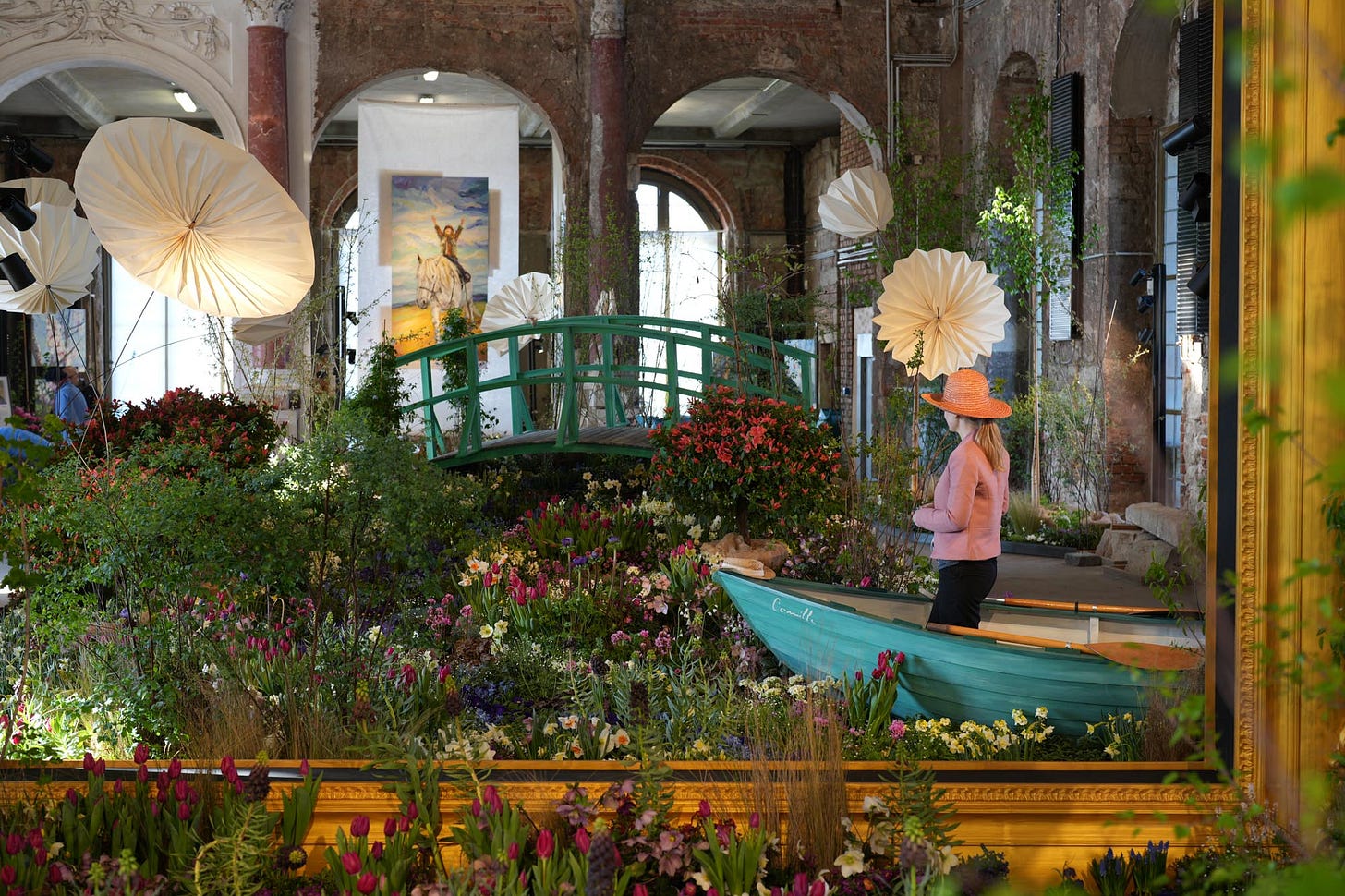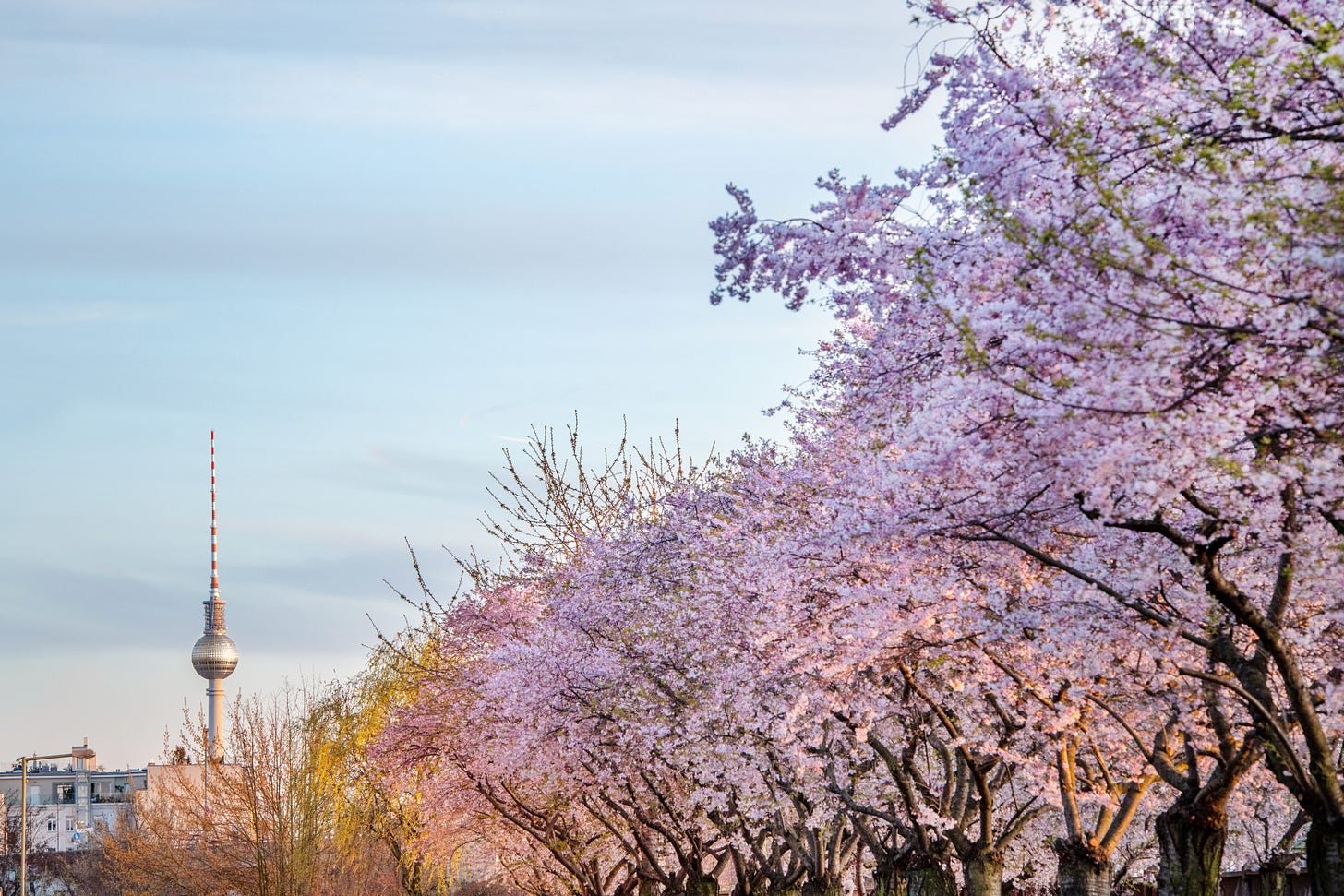Welcome to Germany Travel Picks! This collection of travel tips, inspiration, news and events will (usually) land in your inbox every other Tuesday. Paid subscribers will receive the very first monthly special next Friday, in which I answer one of the questions I’m asked most: where to eat in Berlin. If you don’t want to miss out…
In the meantime, here’s some springtime travel inspiration - and you can find find some more seasonal tips in last year’s spring newsletter, too.
Destination picks: Germany’s best blooms
It doesn’t officially begin until March 20, but for those who’ve been sitting through a seemingly endless grey winter, spring won’t come a moment too soon. And when it does arrive in Germany, all bright blue skies, dazzling sunshine and an abundance of bright green leaves and pretty flowers, it’s truly a glorious thing.
There’s no way to predict exactly when the first spring blossoms will appear, but the southwestern areas of Germany (Baden-Württemberg, Hessen and Rheinland-Pfalz) being the warmest, you’re likely to find them there first. Head out into the country’s fruit- or wine-growing regions to wander along lanes lined with almond, apple or peach trees covered in delicate pink and white blooms. There are some spectacular spring sights to be found in urban areas, too, in part thanks to a gift of 9,000 ornamental cherry trees sent to Germany by a Japanese television station in 1990 in celebration of German reunification. The streets of cities such as Hamburg, Magdeburg and Berlin are transformed at this time of year, embellished with weighty canopies of flowers. The gardens of Germany’s palaces and castles are a good bet for impressive floral displays, too: Schwetzingen Palace is particularly popular for it’s blush pink blossoms.
Almond blossoms in the Palatinate

Some of Germany’s earliest blossoms emerge along the German Wine Route, a winding road that runs 85km between the towns of Bockenheim and Schweigen-Rechtenbach in the Palatinate wine region. The area is known for its warm climate (and excellent food and wines), and it’s claimed that spring arrives here two to three weeks earlier than anywhere else.
Outdoors enthusiasts should make a beeline for the 100km, seven-stage Palatinate Almond Trail, which quickly transforms into a veritable pink and white ribbon running through the vineyards. There’s a particularly large concentration of almond trees - 2,000 or so - around the village of Gimmeldingen on the edge of the Haardt Mountains: here, the annual Almond Blossom Festival has been celebrated with local wines, regional specialties and the crowning of the Almond Blossom Queen since 1934. Other regional highlights include the Palatinate Almond Festival, which runs from the beginning of March to mid-April and offers a programme of culinary events as well as excursions on foot, by bike, or even in a vintage bus. Further south in Edenkoben, the so-called Almond Mile festival (18-19 and 25-26 March) sees the town’s winegrowers and restaurateurs setting up stalls beneath the blossoming trees with a magnificent panoramic view. And if you’ve not seen enough pink during the daytime, a number of historic buildings in the region including Wachtenburg, Hambach and Trifels castles are, until April 15, illuminated with bright pink light at night.
Crocuses by the North Sea
The largest crocus population in northern Europe is to be found in the landscaped gardens of 16th-century Husum Castle in the charming seaside town of Husum on the North Sea coast. Four million of the low-growing flowers open their pretty purple petals here each spring and are celebrated at the annual Husum Crocus Blossom Festival (18-19 March). The festival opens with the coronation of the incoming Crocus Blossom Royalty on the steps of the Old Town Hall on Husum’s Market Square and continues with events including an arts and crafts market in the castle courtyard, a culinary mile in the Husum’s centre, a marching brass band, and a variety of guided tours.
Bonn’s Insta-famous blooms
Bonn’s ornamental cherry trees were planted at the end of the 1980s as part of an urban redevelopment plan to improve the city’s then dreary-looking old town. And boy, did it work: today, visitors flock here from far and wide each spring for a glimpse of what have become two of Germany’s most-Instagrammed streets.
Several varieties of cherry were planted in Bonn’s old town, and their differing flowering periods usually overlap between the end of March and mid- to late April. The first, very pale and delicate blossoms appear on Maxstraße before spreading through the surrounding streets and coming to a dramatic climax in Heerstraße and Breite Straße, where 60 trees of a variety known for its luscious, deep pink flowers, turn the streets into magnificent pink tunnels. These two streets can get rather packed with visitors taking photos, so try heading there early morning or evening if you want to beat the crowds.
Opulent floral displays in Dresden
After three years on hold, Germany's most prominent spring flower show has returned. The Dresdner Frühling im Palais (Dresden Spring in the Palais) takes place in the impressive baroque palace at the Grand Garden of Dresden. Continuing a long tradition of extravagant flower shows in the Saxon capital, the slogan for this year’s show is “Picture-perfect: flowers by the artist’s hand”. Some of Saxony’s best known florists, gardeners, calligraphers, light and sound designers have recreated famous artworks using over 40,000 plants, from tulips, daffodils and hyacinths to anemones, hellebores and ornamental apples - all of which they’ve somehow managed to get to flower at the same time. Until 12 March.
Cherry blossoms in Berlin
Largely thanks to the generous Japanese gift of cherry trees 30 years ago, pockets of the German capital are positively flooded with pink blossom each spring. The city’s tourism board has even published a handy blossom guide (.pdf ) that pinpoints some of the best locations to enjoy them.
If you fancy combining your search for spring bloomcore with some schooling on Berlin’s history, pick yourself a section of the Berlin Wall Trail to wander. The 160km hiking and cycling route traces the course of the former GDR border fortifications encircling West Berlin and offers some of the best places to enjoy cherry blossoms in the city. Highlights include Glienicke Bridge (the Bridge of Spies), where the first Japanese cherry trees were planted; TV-Asahi-Kirschblütenallee, on the former border strip between Teltow and Berlin-Lichterfelde, where an annual Japanese Hanami Cherry Blossom Festival takes place; the Oberbaum Bridge (pictured top); and the sprawling Gardens of the World, which also hosts an annual cherry blossom festival, featuring stage performances and a cosplay competition.
Travel news: Get ready for the 49€ ticket
The new monthly 49€ subscription ticket from Deutsche Bahn, which allows ticket holders unlimited travel on all forms of local public transport (excluding ICE and IC/EC trains), will be valid from 1 May. You can now register to be notified when it becomes available.
If you enjoyed this, you might also like…
Rail route of the month: a steam-hauled climb through Germany’s Harz mountains • 23 Most Beautiful Small Towns Around the World — From Popular Spots to Hidden Gems (Rothenburg ob der Tauber, #16) • The 20 Best Places In Europe To Visit In 2023 (Essen, #6) • I Visited Some of Europe's Most Charming Spa Towns by Train — Here's What It Was Like








Nicely written! I enjoyed it!
Lovely to read you again! and looking forward to the spring in Germany!